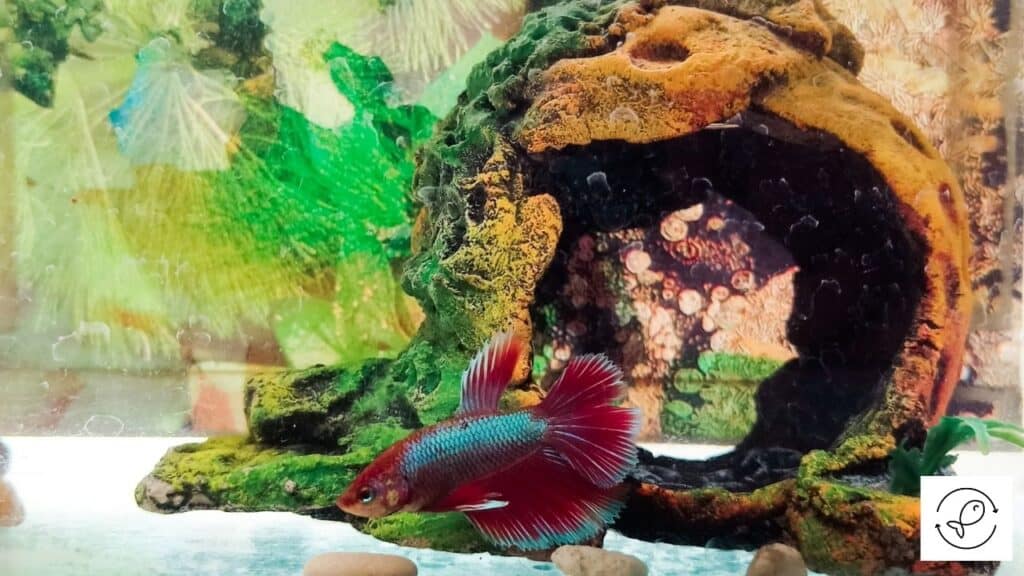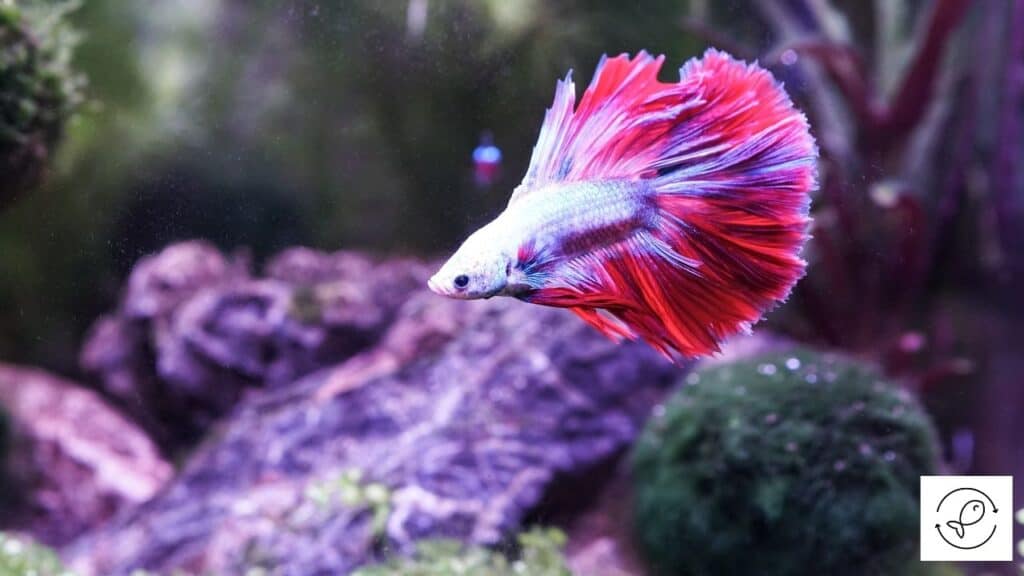It’s best to keep one or a maximum of two female bettas in a 5-gallon tank, 4 to 5 female bettas in a 10-gallon tank, and so on. Female bettas are territorial and aggressive, which leads to stress and weak immune systems. So it’s essential to provide ample space for them to create their territories.
Let’s now understand the ideal tank size for female bettas.
Ideal Tank Size For Female Bettas
A group of female bettas is called a betta sorority.
Basically, a sorority usually means a group of people or animals who share similar interests or goals.
A tank that keeps several female betta fish is known as a sorority tank.
When it comes to betta sororities, they usually consist of four or more female bettas living together.
Given below is the ideal tank size for keeping various numbers of female bettas together.
| Tank Size | Number of Female Bettas |
|---|---|
| 5 Gallons | 1 or 2 (max) |
| 10 Gallons | 4 to 5 female bettas |
| 15 Gallons | 6 to 7 female bettas |
| 20 Gallons | 8 to 10 female bettas |
| 25 Gallons | 10 to 12 female bettas |
Having a betta sorority with more than ten female bettas isn’t recommended.
So for a larger tank, you can add more decor and vegetation to create hiding places and large territories to keep the female bettas calm.
Can You Keep Female Bettas Together?
Female betta fish can live together. However, female bettas can get territorial and engage in mild conflicts to establish their position in the social hierarchy. So, provide enough space for all the inhabitants using rocks, stones, and aquatic plants to create territories.
The betta sorority should be at least four to five females but not more than ten if the aquarium is large.
It can seem easy to set up a female betta tank, but there are specific steps you need to follow to ensure success.
You can begin a betta sorority with 4 to 5 female bettas in a 10-gallon tank.
Bettas aren’t naturally schooling fish, so make sure the tank has enough dense plants and hiding places.
The shelter will make the fish feel secure, create territories, and keep them away from each other when they want to be alone.
Whether you should keep betta fish together seems to be an ongoing debate.
Besides, it’s important to note that some fish enthusiasts caution against keeping two bettas together unless they’re kept for breeding.
To sum up, betta sororities involve some setup and research before you can keep the fish together.
How To Setup A Betta Sorority?
The essential part of a successful betta sorority is providing your bettas with the appropriate water and tank conditions.
Given below are some important factors to keep in mind while creating a betta sorority.
1. Tank Size
The ideal tank size for betta fish is 20 to 30 gallons.
A bigger tank provides more space for every sorority member to hide and stay out of each other’s way.
Bettas are surface breathers and prefer to eat at the tank’s surface.
So you must consider a long and shallow tank to reduce confrontations and stress for your bettas.
2. Number Of Bettas
A betta sorority must contain four or five betta fish.
Unlike male bettas, female bettas can have minor squabbles until the hierarchy is established within the sorority.
You can have up to ten female bettas in the sorority if you have a large tank.
However, you must ensure enough space inside the tank for every member to create their territory.
3. Betta Species
Some fish owners have observed female bettas displaying aggressive behavior toward fish that look very similar.
So it’s best to have a betta sorority with different types of bettas.
4. Natural Habitat

When creating an environment inside the tank, create hiding places using decor like rocks, caves, plants, etc.
Every sorority member needs its territory.
So aquatic plants, caves, rocks, driftwood, etc., can divide the tank space and help to create multiple territories.
This will help to de-stress the bettas and keep them calm.
5. Water Temperature
Betta fish need ideal water conditions to thrive.
The ideal water temperature is in the range of 76°F to 80°F (25°C to 27°C).
In captivity, bettas need a temperature of 75°F to 82°F (23.8°C to 27.7°C).
Bettas will get stressed if they aren’t kept within the required temperature range.
It will also impact their immune system, allowing bacterial and fungal infections causing fin rot, white spots, and dropsy.
6. Tank Filtration And Maintenance
To keep the tank water clean, you must install a robust filtration system in your betta tank.
It will help reduce fish waste and the build-up of harmful substances inside the tank.
Leftover food, fish waste, and decomposing plant matter can result in the build-up of ammonia, nitrites, and nitrates in the water.
So a robust filtration system and regular tank maintenance can help maintain the required water parameters.
7. Introduction Of Bettas To The Tank
The most crucial advantage of introducing all of the female bettas in the tank at once is that it helps reduce territorial disputes.
You will need to monitor their behavior though. Hopefully, all the bettas will settle down within a short time.
However, if any female betta is continuously bullying other fish, you must remove the aggressor as you don’t want to stress the other bettas.
You can try to re-introduce the aggressor after 30 to 60 minutes.
But if the problem persists, it’s best to keep the bully in a separate tank.
This will maintain peace and harmony in the tank.
Can Betta Sorority Fail?
The betta sorority can fail due to the potential stress it causes to the fish in the tank. Besides stress, there are other reasons like constant injuries due to aggression, the rapid spread of infections, and the lack of fish owners’ time, effort, and expertise to handle a betta sorority.
It’s not easy to keep two territorial fish like bettas together.
Female bettas aren’t nearly as aggressive as males, but they will always show territorial instincts.
If the sorority isn’t monitored, things can go out of hand rapidly.
For example, if the stronger bettas bully a weaker betta, it will constantly remain in hiding and will not be able to find food.
As a result, the weaker betta will become malnourished and even starve in extreme cases.
The confrontation can also lead to injuries and parasite build-up in the tank.
Just like any other aquarium, you need to pay more attention when you have more fish in the tank.
The tank needs to be cleaned regularly to maintain the required water quality and keep the occupants happy.
To maintain a betta sorority, the fish owner needs to be invested by providing the required time, effort, and money.
Otherwise, sorority can become a painful experience for the fish and the owner.
Why Shouldn’t You Have A Betta Sorority?
A betta sorority looks like an excellent idea for new aquarium enthusiasts.
They’re amazed by the idea of keeping many colorful female bettas in a single tank.
However, many expert aquarists disagree with the idea of a betta sorority.
They believe it tends to have underlying problems that are difficult to discover and can’t be handled or eliminated entirely.
Given below are some of the potential problems in having a betta sorority.
1. Constant Stress
Keeping female bettas together will never create a violent situation, unlike their male counterparts.
However, you will see some mild confrontations and chases.
So although they aren’t overtly attacking each other, there’s always some tension.
Unfortunately, this submissive behavior creates stress for the female bettas.
The stress stripes are visible in the red and blue bettas but not on the white and yellow ones.
Besides, numerous other issues like clamped fins, darting, constant hiding, lack of appetite, and rapid breathing can be observed in a sorority.
2. Rapid Spread Of Diseases And Illnesses
Living under stressful conditions will affect the immune system of female bettas.
Having a betta sorority increases the risk of infections and illnesses.
In extreme cases, there are chances of all the aquarium fish getting affected.
The rapid spread of infections throughout the tank will make all the inhabitants suffer.
You will also get stressed as you will have to deal with emergencies.
3. Constant Injuries
Bettas are known to be quite hardy. But when it comes to handling injuries, they tend to get upset and fight back.
In a betta sorority, there’s a high chance of coming across fish with torn fins, missing scales, and other wounds.
Besides, these wounds can make fish susceptible to bacterial infections.
These injuries will also make the fish struggle to do even primary tasks like reaching out for food, swimming, etc.
4. Needs Time, Effort, And Money
The problem with a sorority is that you can’t always keep the group under control. It means there can be some fatalities and injuries.
Even if you do everything right, there are some things you can’t control.
So there will be fights, and you will have to tend to the betta fish almost immediately.
So keeping a sorority isn’t the best idea if fish owners can’t put in the required time, effort, or money to create conditions that can help female bettas cohabitate.

